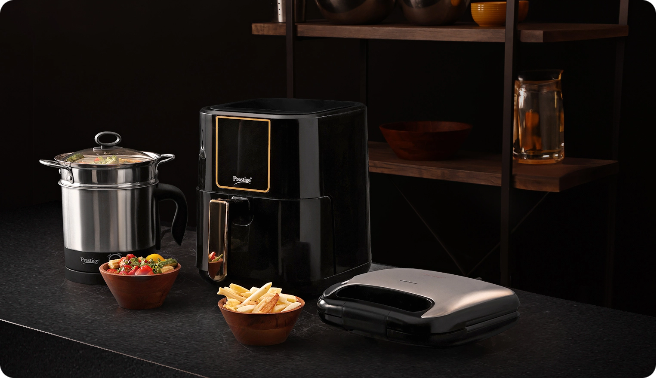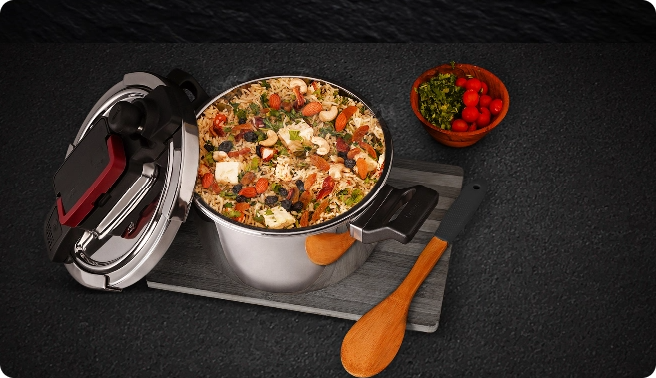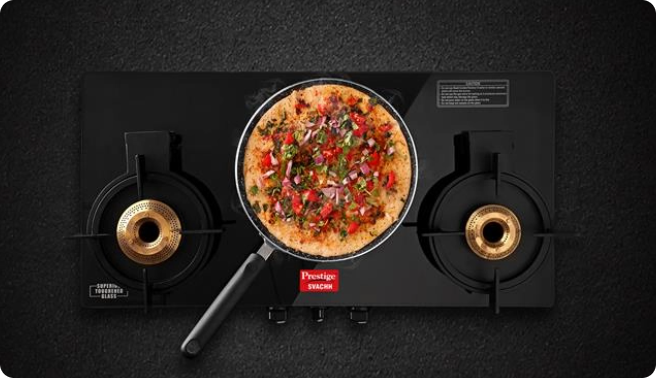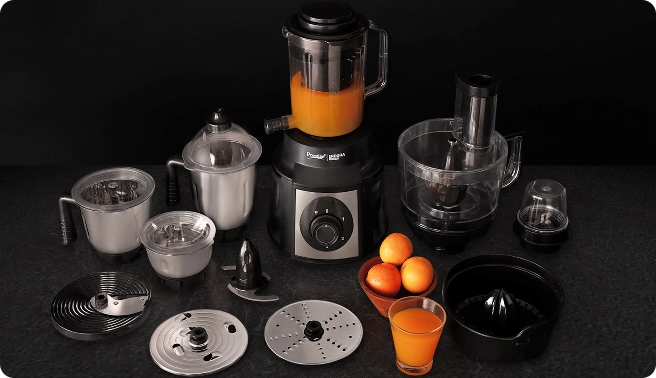In every Indian kitchen, rotis are more than just food—they’re tradition, comfort, and daily nourishment. For generations, the rhythmic sound of rolling pins and the aroma of hot rotis on tawas have defined home-cooked meals. But with busier lifestyles and smarter kitchens, electric roti makers offer a tempting alternative.
As more households balance tradition with technology, the question arises: Should we stick with the time-tested method or embrace convenience? This guide compares both approaches—traditional and modern—so you can choose what works best for your routine, taste, and values.
Roti Making: Then and Now
Traditional roti making is a skillful, hands-on process passed down over generations. From kneading and rolling to puffing on a hot tawa, it demands attention and experience. Each region has its nuances, making every family’s rotis unique.
Roti makers, in contrast, bring automation to the table. From heated plates to semi automatic appliances, they promise quicker, more consistent results with no rolling or flipping needed.
Choosing between the two isn't just about saving time—it's about flavor, texture, cost, cultural connection, and everyday practicality. Some families even combine both methods, leaning on tradition when time allows and using appliances for rolling and cooking to cook faster.
Why This Comparison Matters
Modern Indian families juggle careers, chores, and wellness goals. Time-saving tools like roti makers are attractive—but not without trade-offs. Many wonder if the ease is worth a possible dip in taste or emotional value.
There’s also a financial angle: traditional methods require little investment, while roti makers demand an upfront cost. This guide helps weigh those pros and cons clearly, so you can make a decision that fits your kitchen and lifestyle.
Traditional Roti Making - Step-by-Step Process
1. Kneading the Dough
Great rotis start with well-kneaded dough. Traditionally, this means combining whole wheat flour with water in a ratio of about 2:0.75, adjusting for flour type and humidity. Water is added gradually while mixing by hand or with a spoon. A pinch of salt and a bit of oil may be added for flavor and texture.
Kneading involves pushing the dough with the heel of the palm, folding, rotating, and repeating for 8–10 minutes until it's smooth, elastic, and slightly sticky. A properly kneaded dough feels like an earlobe—supple yet firm—and doesn’t stick excessively. It rests for 20–30 minutes under a damp cloth to relax the gluten.
2. Rolling the Rotis
Rolling is a skill built over time. The rested dough is divided into golf-ball-sized portions, dusted with flour, and flattened. Using a wooden rolling pin, even pressure and rotation help maintain circular shape and 2–3 mm thickness.
Too much pressure toughens the roti; too little leads to uneven cooking. While a perfect circle isn't essential, it’s a sign of finesse. Rotate the dough slightly after each roll and dust lightly to avoid sticking. Some prefer rolling all rotis before cooking; others roll and cook simultaneously, depending on kitchen setup.
3. Cooking on the Tawa
The roti is cooked on a hot tawa—cast iron, steel, or non-stick—preheated so water droplets sizzle on contact. One side cooks for 30–45 seconds until bubbles form and light spots appear, then it's flipped for another 20–30 seconds.
For puffing, the roti can be placed over a flame using tongs, allowing steam to create soft layers inside. This step, while optional, enhances texture. Heat control is crucial: too high burns the outside; too low makes rotis tough. Skilled cooks rely on sight, sound, and touch to get it right.
Tools Used in Traditional Roti Making
1. The Rolling Pin: An Extension of Skill
The belan, or Indian rolling pin, is central to flatbread preparation. Unlike Western pins with handles, the belan is a smooth, solid wooden cylinder that offers excellent control and responsiveness. Crafted from hardwoods like sheesham, teak, or mango, traditional belans are durable, moisture-resistant, and naturally non-stick when properly maintained.
New belans are seasoned with oil to build a slick surface, and ongoing care includes gentle washing, drying, and occasional oiling to prevent cracking or flavor absorption. Typically 12–14 inches long and about 1.5 inches thick, the ideal belan offers the right balance of weight and maneuverability for effortless rolling.
Modern alternatives include stainless steel and marble pins—steel for ease of cleaning and marble for cool handling in warm climates. Still, seasoned cooks often favor wood for its tactile feedback and control.
2. The Tawa: Heart of the Cooking Process
The tawa, a flat griddle, is essential for transforming dough into fully cooked rotis. Traditional options vary in material, each offering unique benefits and care routines.
Cast iron tawas are prized for heat retention and even cooking. Once seasoned, they become naturally non-stick and improve with use, though they require oiling and rust prevention.
Carbon steel tawas offer similar benefits with less weight and faster heat response, appealing to those who prefer precise control. Non-stick tawas, while easier to clean, are less durable and must be handled carefully to avoid surface damage.
Traditional tawas are 10–12 inches wide, with a slightly concave shape that aids flipping and keeps rotis centered. Proper maintenance—cleaning, seasoning (for metal tawas), and careful storage—ensures longevity. Mastery comes with experience, but beginners can rely on visual and sound cues to judge heat and doneness.
8 Timeless Advantages of Traditional Roti Making
Despite modern innovations, millions of households still swear by traditional roti-making—and for good reason. From richer taste to cultural depth, here’s why going old-school with your belan and tawa is more than just nostalgia.
1. Superior Taste and Texture Control
Traditional roti making gives you complete control—from the dough's hydration to how long each side cooks. You can adjust in real-time for things machines can't account for—like humidity, flour type, or how soft you want your rotis.
Want thinner rotis? A slight press. Craving stuffed ones? Just tweak the filling. Machines? They’ll do one thing well—but only that one thing.
2. Real-Time Adaptability to Ingredients and Climate
Dough behaves differently on rainy days. Traditional methods let you respond instantly—add more flour, knead longer, adjust the flame. Automated appliances? Not so much. They struggle with non-standard conditions.
3. Total Creative Freedom
Want to add ajwain to the dough? Try a missi roti or experiment with different thicknesses for wraps and snacks? Traditional tools let you do it all. Automated roti makers don’t offer the same room for improvisation or variety.
4. Minimal Equipment, Maximum Return
All you really need is a belan, a tawa, and a bowl. No power cords, no high-tech gear. With proper care, these tools can last a lifetime, unlike electric appliances that often wear out or need replacement.
5. Low Operating Costs
Traditional roti making uses the same gas stove you already cook with. No extra electricity. No servicing. No spare parts. It’s energy-efficient, especially in households that make rotis daily.
6. Builds Skill and Cultural Connection
Learning to make rotis is like learning an art form. You develop intuition—about heat, dough consistency, timing—all of which translate into better cooking overall. Plus, it's a beautiful way to connect with your roots and pass traditions down through generations.
7. Therapeutic and Mindful
The process of kneading, rolling, and roasting can be calming, almost meditative. It invites presence and focus—something no automated process can offer. Many find traditional roti making to be a soothing daily ritual.
8. Flexible for Every Need and Diet
Need just one roti? Or twenty? Traditional methods scale effortlessly. Have gluten intolerance? Want to use millet flour? No problem. The process adapts. Most electric roti makers can’t handle non-standard flours or custom portion sizes.
Disadvantages of Traditional Roti Making
While traditional roti making has its charm and deep-rooted cultural value, it's not always the most practical choice—especially in today’s fast-paced world. Here are the top disadvantages to keep in mind before committing to this age-old method.
1. Time-Consuming and Labor-Intensive
Making rotis the traditional way isn't a quick task. Preparing dough, rolling, and cooking a family-sized batch can take 45 minutes to an hour—every single day. For working professionals or busy parents, this time commitment can feel overwhelming.
2. No Room for Multitasking
Unlike curries or rice that can simmer unattended, roti making demands your constant attention. You can’t step away—not even for a minute. That means zero multitasking and a fully hands-on process.
3. Physically Demanding
Rolling dozens of rotis, managing a hot stove, and standing for extended periods can be tiring. This is particularly taxing for elderly individuals or anyone with wrist, shoulder, or back issues.
4. Messy Cleanup
Expect flour everywhere—on countertops, rolling boards, and even the floor. Add in oil splatters on the stove, and cleanup can easily take as long as cooking. It’s not ideal for those seeking a quick, tidy kitchen routine.
5. Steep Learning Curve
Perfect rotis aren’t made overnight. Getting the dough right, rolling evenly, and cooking to perfection takes practice—and patience. Beginners often face lumpy dough, misshapen rotis, and uneven cooking before getting it right.
6. Inconsistent Results for Beginners
Without experience, results vary. One day your rotis might puff beautifully; the next, they could turn out stiff or half-cooked. This inconsistency can be frustrating, especially when you're hungry and short on time.
7. Sensitive to Environment and Equipment
Traditional roti making is surprisingly affected by things like humidity, flour type, or even your stove. Gas burners offer fast heat control, but induction or electric stoves might throw off your timing. Plus, environmental conditions can mess with dough hydration and cooking time.
How Does Roti Maker Work
Roti makers automate much of the manual effort and guesswork involved in traditional roti making. They use heated, non-stick plates with thermostatic controls to maintain consistent temperatures, ensuring even cooking without constant supervision.
Basic Functionality
Most electric roti makers have two circular, non-stick plates that press and cook the roti from both sides. Built-in temperature control maintains optimal heat, removing the need to manually adjust flames or monitor cooking constantly. Many models also include timers or auto shut-off features, allowing for multitasking.
Types of Roti Makers
-
Semi-Automatic: You roll the dough and place it in the machine. It cooks the roti evenly but still requires prep work.
-
Fully Automatic: These machines handle everything—from dough pressing to puffing rotis. They’re more expensive and complex but save the most time.
-
Specialized or Commercial Models: Designed for high output or durability, often used in restaurants or large households.
User Experience
Modern roti makers are easy to use with simple buttons, dials, and ready indicators. Preheating takes about 3–5 minutes. Once ready, you place the dough or rolled roti inside, close the lid, and wait 2–4 minutes while it cooks—no flipping needed. Lights or beeps let you know when it’s done.
Advantages of Roti Makers
1. Time-Saving Convenience
Roti makers drastically reduce active cooking time, freeing you to multitask in the kitchen.
This is especially helpful during busy mornings or when preparing meals for the entire family.
2. Quick Setup and Easy Cleanup
Unlike traditional setups that require multiple tools, roti makers involve minimal preparation and mess.
Most models just need a preheat and wipe-down, making them ideal for those who prefer hassle-free cooking.
3. Batch Cooking Efficiency
Some models can prepare several rotis in succession with minimal extra effort.
This is great for large households or when hosting guests, helping save effort during bulk preparation.
4. Consistent Cooking Results
Automated temperature and pressure controls ensure evenly cooked rotis every time.
Even beginners can produce visually appealing, soft rotis without constant supervision or experience.
5. Reduced Skill Requirement
You don’t need to master rolling, flipping, or temperature control to get good results.
This makes roti makers an excellent tool for those new to cooking or those who lack confidence in traditional techniques.
6. Fewer Cooking Errors
Pre-programmed settings prevent common mistakes like burnt or undercooked rotis.
This not only ensures consistency but also reduces food waste and frustration.
7. Encourages Beginners
The reliability of results builds confidence and inspires users to experiment with roti making.
Over time, this can even spark interest in learning traditional cooking methods.
8. Energy Efficiency
Modern roti makers are designed to optimize energy use, making them cost-effective in the long run.
They consume less power than keeping gas burners on for extended periods.
9. Safety Features
Enclosed designs eliminate exposure to flames and hot surfaces, making them safer than stovetop methods.
This is particularly valuable in households with children or elderly members.
10. Built-in Auto Shut-Off and Protection
Most models come with safety mechanisms like auto shut-off and thermal protection.
These prevent overheating and accidents, offering peace of mind during unattended use.
Prestige PRM 3.0 Plain Plate Roti Maker
The Prestige PRM 3.0 Plain Plate Roti Maker is designed for effortless and efficient roti making, perfect for today’s fast-paced lifestyles. Built with a durable body and a non-stick coating, it ensures that your rotis come out soft, fluffy, and evenly cooked—without sticking or tearing. The power indicators provide clear signals when the appliance is ready to use, while the adjustable temperature knob gives you full control over the heat, allowing you to customize cooking based on dough type and preference. Sleek, user-friendly, and dependable, the Prestige PRM 3.0 transforms your everyday roti routine into a hassle-free experience.
Disadvantages of Roti Makers
1. High Initial Cost
Quality roti makers require a substantial upfront investment compared to traditional tools.
This may not be justifiable for those who prepare rotis infrequently.
2. Ongoing Electricity Costs
Using a roti maker regularly can add to your monthly power bills.
For budget-conscious households, this recurring cost can become a concern over time.
3. Maintenance and Repairs
Like any appliance, roti makers require regular cleaning and occasional servicing.
Unexpected breakdowns or part replacements can be inconvenient and costly.
4. Depreciation Over Time
Unlike traditional tools, electric appliances lose value and utility over the years.
They may need replacement once manufacturer support ends or parts become obsolete.
5. Limited Roti Size and Thickness Options
Most machines allow only preset sizes and thicknesses, limiting customization.
This can be frustrating for those who prefer larger, thinner, or thicker rotis based on personal taste or regional style.
6. Not Ideal for Specialty Rotis
Roti makers struggle with variations like stuffed parathas, millet rotis, or flavored doughs.
This restricts creativity and experimentation in the kitchen for adventurous cooks.
7. Smaller Batch Size Per Cycle
Many models only cook one roti at a time, slowing down production during peak meal times.
This limitation can negate the time-saving benefit when cooking for large groups.
8. No Real-Time Adjustments
You can’t tweak temperature or timing mid-cycle like in traditional cooking.
This lack of flexibility may lead to results that can’t be corrected on the spot.
9. Cleaning and Component Sensitivity
Non-stick surfaces and internal parts require delicate cleaning and protection from moisture.
Improper maintenance can shorten the machine’s life or compromise food safety.
10. Taste and Texture May Fall Short
Machine-made rotis may lack the soft, puffed texture or charred flavor of traditionally cooked ones.
This could disappoint purists who associate rotis with specific homemade qualities.
For more information you can also read Tips and Tricks for Roti Makers
Conclusion
Which One Is Right for You?
Choosing between traditional and automated roti making depends on your lifestyle, priorities, and kitchen goals. It’s a balance of control vs. convenience, cost vs. time, and tradition vs. technology.
Lifestyle & Time
Busy professionals or parents may find roti makers a game-changer—saving time and making daily meals more manageable. Just load and go, freeing up your hands for other tasks.
If you enjoy cooking as a mindful or creative activity, traditional methods offer a rewarding, hands-on experience that can double as stress relief.
Family Needs & Frequency
Large families may benefit from the speed and consistency of machines, while smaller households might prefer the flexibility and tactile joy of handmade rotis. If you make rotis daily, a machine may be worth the investment—less so for occasional use.
Frequently Asked Questions (FAQs)
1. Are TTK Prestige roti makers worth it compared to traditional methods?
A. Yes—if you make rotis regularly and want to save time, the investment is worthwhile. For occasional use or if you enjoy traditional cooking, it may not offer enough value. Consider how often you cook, your time constraints, and budget.
2. Do rotis from Prestige roti makers taste the same as traditional ones?
A. They’re close, but not identical. Traditional methods offer more control and that signature puffed texture. Roti makers give consistent, good-tasting results—especially when the dough is well-prepared.
3. How much electricity do they use?
A. They consume about 900–1200 watts, costing around ₹2–4 per day with regular use. Monthly expenses are typically ₹60–120—reasonable for the time and effort saved.
4. What maintenance is needed, and how long do they last?
A. Just wipe with a soft cloth and mild detergent after use. Avoid abrasives. With care, they last 3–5 years. Non-stick coating may need replacing in 2–3 years. Prestige offers reliable service and parts.
5. Can they handle different dough types or flatbreads?
A. Yes, they work with wheat, multigrain, and some gluten-free doughs. They can make rotis, chapatis, and small parathas (no stuffing). Dough consistency matters—very soft or thick doughs may not cook evenly.















